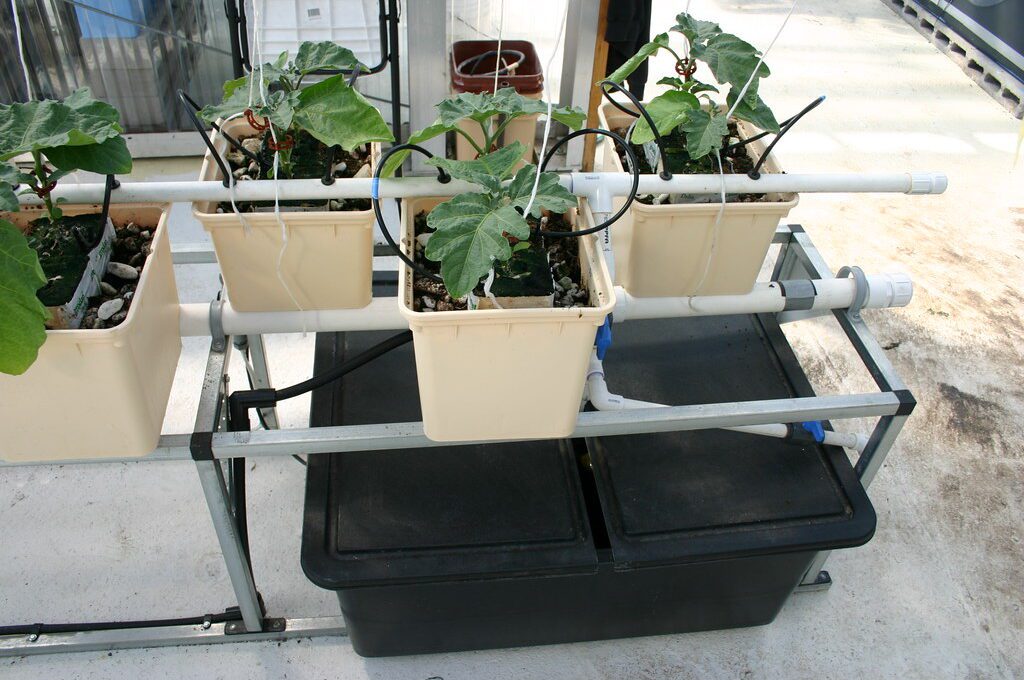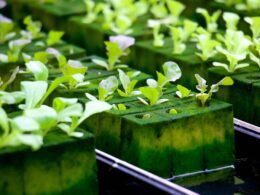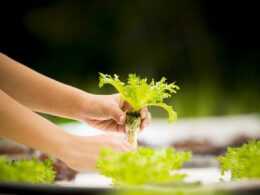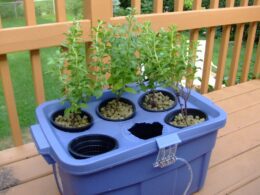Are you interested in growing plants without soil? Hydroponics is a great way to do just that. With hydroponics, you can grow plants in a controlled environment and provide them with everything they need to thrive.
However, to ensure your plants grow successfully, there are six requirements you need to fulfill.
First, you need to provide your plants with a nutrient solution. Without soil, plants cannot obtain the necessary nutrients they need from the ground. Instead, you need to provide a nutrient-rich solution that contains all the necessary elements for plant growth.
This solution needs to be balanced and tailored to the specific plants you are growing, as different plants have different nutrient requirements. By fulfilling this first requirement, you are setting your plants up for success and ensuring they have everything they need to grow strong and healthy.
Nutrient Solution
If you wanna grow some plants without any soil, you gotta make sure your hydroponic nutrient solutions are on point. Nutrient solutions are the backbone of hydroponics, as they provide all the necessary minerals and nutrients that plants need to grow.
Unlike soil-based growing, hydroponic nutrient solutions should be tailored specifically to the plants you’re growing and their nutrient requirements. Hydroponic nutrient solutions are made up of water and various minerals and nutrients that are essential for plant growth.
The exact nutrient requirements will depend on the type of plants you’re growing, as each plant has its unique set of nutrient needs. You can buy pre-made nutrient solutions that have been specially formulated for different types of plants, or you can make your nutrient solution by mixing various minerals and nutrients in water.
It’s essential to monitor your hydroponic nutrient solutions regularly to ensure that the plants are getting the right amount of nutrients. If the nutrient solution is too weak, your plants won’t grow to their full potential, and if it’s too strong, it can damage the plants.
You can use various tools to monitor your nutrient solution, such as pH meters and nutrient testing kits, to ensure that your plants are getting the right amount of nutrients they need to thrive.
Growing Medium
When it comes to hydroponics, the choice of growing medium is crucial. Different types of growing mediums have their own advantages and disadvantages, and it’s important to choose the right one for your specific needs.
In this discussion, we’ll explore the different types of growing mediums available and how to choose the best one for your hydroponic system.
Advantages and Disadvantages of Different Growing Mediums
Choosing the right growing medium is crucial for the success of your hydroponic system. There are several options available, and each one has its own set of advantages and disadvantages. It’s important to weigh the pros and cons of each option before deciding which one to use.
One of the most popular growing mediums is rockwool. It’s easy to use and has good water retention properties, which can help reduce water usage. However, it can be expensive and difficult to dispose of properly.
Another option is coco coir, which is made from coconut husks. It’s a renewable resource and has good water retention properties. However, it can be prone to fungal growth and may require additional nutrients to be added.
Finally, there’s clay pebbles, which are inexpensive and reusable. However, they can be heavy and may require additional support for larger plants.
By doing a cost analysis and considering the pros and cons of each option, you can make an informed decision on which growing medium is best for your hydroponic system.
Choosing the Right Growing Medium
To ensure the success of your hydroponic system, it’s essential that you carefully select the appropriate growing medium based on its unique properties and benefits. Consider the following when choosing the right growing medium for your plants:
- Choose a medium that can hold water but also allows for proper drainage to prevent over-saturation and root rot.
- Opt for a medium with a pH level that complements the nutrient solution your plants require for optimal plant nutrition.
- Look for a medium that provides adequate air circulation to the roots of your plants, ensuring they receive the oxygen they need to thrive.
Additionally, you may want to consider the cost, availability, and eco-friendliness of the medium you select.
By taking the time to choose the right growing medium for your hydroponic system, you’ll be setting yourself up for success in providing your plants with the necessary nutrients to grow and thrive.
Oxygenation
You need to make sure your plants have enough oxygen in their nutrient solution to thrive in your hydroponic system. This is because plants need oxygen to absorb nutrients and grow properly. Without enough oxygen, your plants may become stunted and weak, or even die.
Fortunately, there are several oxygenation techniques you can use in your hydroponic system to ensure your plants get the oxygen they need. One of the most popular oxygenation techniques is aeroponics, which involves misting the roots of your plants with a nutrient solution. This method allows for maximum oxygenation, as the roots are exposed to air and the mist provides a constant supply of nutrients. The benefits of aeroponics include faster growth rates, higher yields, and healthier plants overall. However, aeroponics can be more difficult to set up and maintain than other oxygenation methods.
Another method of oxygenation is using an air pump to bubble air through the nutrient solution in your hydroponic system. This is a simple and effective way to ensure your plants get enough oxygen, and is often used in combination with other methods like using an air stone or diffuser.
By incorporating these oxygenation techniques into your hydroponic system, you can ensure your plants have the best chance of thriving and producing a bountiful harvest.
What factors affect the growth timeline of hydroponic plants?
Factors such as plant species, nutrient solution, temperature, light intensity, and pH levels significantly impact the how long hydroponics growth duration. Plant varieties have varying growth rates, while nutrient balance and solution strength influence their overall development. Providing optimal temperature, light levels, and maintaining an ideal pH range further determine the growth timeline of hydroponic plants.
pH Monitoring
Now it’s important to keep an eye on the pH levels in your nutrient solution if you want your plants to grow strong and healthy. pH refers to the acidity or alkalinity of the water.
The ideal pH level for hydroponics is between 5.5 to 6.5. If the pH level is too high or too low, it can affect the absorption of nutrients by the plants, which can lead to stunted growth and other problems.
To monitor the pH level, you need a pH meter and pH test strips. You’ll need to take regular readings of the nutrient solution and adjust the pH level accordingly.
It’s important to keep a record of the pH level readings and any adjustments you make. This data analysis will help you troubleshoot any problems that may arise in the future.
Troubleshooting pH level issues can be challenging. If the pH level is too high, you can add a small amount of pH down solution. If the pH level is too low, you can add a small amount of pH up solution.
It’s important to add the solution gradually and take regular readings until you reach the desired pH level. Remember to always follow the instructions on the pH solution bottles and use protective equipment such as gloves and safety glasses.
By keeping an eye on the pH levels and troubleshooting any issues, you can help ensure that your hydroponic plants grow strong and healthy.
Lighting and Climate Control
When it comes to hydroponics, one of the most important factors to consider is lighting. There are several types of grow lights to choose from, each with their own benefits and drawbacks.
Additionally, controlling temperature and humidity is essential for creating the ideal growing environment for your plants.
Types of Grow Lights
When it comes to hydroponics, the types of grow lights you use can make a big difference in the success of your plants. LED, fluorescent, and high-pressure sodium (HID) are the most common types of grow lights used in hydroponic systems.
LED lights are popular because they use less energy and produce less heat than HID lights. They also have a longer lifespan and can be more easily adjusted to different light spectrums for plant growth. On the other hand, HID lights are known for producing more intense light and are often preferred for larger grow operations.
It’s important to consider the light spectrum when choosing grow lights for your hydroponic system. Plants require different wavelengths of light for different stages of growth, and different types of grow lights emit different spectrums of light.
For example, blue light is important for vegetative growth while red light is important for flowering. LED lights can be adjusted to emit specific spectrums of light, making them a popular choice for hydroponic growers who want precise control over their plants’ growth.
Ultimately, the type of grow light you choose will depend on your specific needs and preferences, as well as the needs of your plants.
Temperature and Humidity Control
Maintaining optimal temperature and humidity levels is crucial for creating the perfect environment for your plants to thrive and reach their full potential. When it comes to hydroponics, it’s important to understand that the temperature and humidity levels needed will vary depending on the type of plant you are growing.
Generally, most plants thrive in temperatures between 65-80 degrees Fahrenheit and humidity levels between 50-70%.
To maintain these levels, it’s important to invest in proper ventilation options such as fans or air conditioning units. These options not only regulate temperature and humidity, but also help prevent the growth of harmful bacteria and mold.
Additionally, pest management is also crucial in maintaining a healthy hydroponic system. Pests such as spider mites, aphids, and whiteflies can quickly infest and damage your plants. By implementing proper pest management techniques, such as using organic pesticides or beneficial insects, you can prevent infestations and keep your plants healthy.
Frequently Asked Questions
How often do you need to change the nutrient solution in hydroponics?
To ensure your hydroponic plants thrive, it’s important to know when to change the nutrient solution. There are a few factors to consider, such as the type of plant and nutrient solution you’re using.
Generally, you should change the solution every one to two weeks, but some plants may require more frequent changes. It’s important to monitor the pH levels and nutrient levels regularly to ensure your plants are receiving the proper nutrients.
Consider using a nutrient solution that’s specifically designed for hydroponics, as it’ll provide the necessary nutrients in the correct ratios. Don’t forget to clean and sanitize your equipment regularly to prevent the growth of harmful bacteria and algae.
By following these guidelines, you can achieve a successful hydroponic garden and enjoy healthy, vibrant plants.
Can you use soil as a growing medium in hydroponics?
Looking for a soil alternative in hydroponics? Good news: you don’t need soil at all! Hydroponics is a method of growing plants without soil, using only a nutrient-rich water solution.
This has several benefits, including more efficient use of resources, faster growth rates, and higher yields. By eliminating soil, hydroponics also reduces the risk of soil-borne diseases and pests, making it a safer and more reliable way to grow plants.
So if you’re looking for a way to grow plants that’s easy, efficient, and safe, hydroponics is definitely worth exploring.
Is it necessary to oxygenate the nutrient solution in hydroponics?
To achieve optimal plant growth in hydroponics, it’s crucial to oxygenate the nutrient solution. This process involves injecting air into the solution to prevent the roots from suffocating and to facilitate nutrient uptake.
By doing so, it enables the plants to absorb the necessary nutrients for growth, resulting in a healthier and more vigorous plant. To oxygenate the nutrient solution, you’ll need equipment such as an air pump, air stones, and tubing, which can cost between $20 to $50 depending on the size of your hydroponic system.
Although it may add to the cost of your setup, the benefits of oxygenation far outweigh the expense, making it a necessary investment for successful hydroponic gardening.
What is the ideal pH range for hydroponic plants?
To ensure your hydroponic plants are healthy and strong, it’s important to maintain an optimal pH range in your nutrient solution.
This range varies depending on the type of plant you’re growing, but generally falls between 5.5 and 6.5.
When pH levels are too high or too low, nutrient absorption can be severely impaired, ultimately slowing down plant growth rate or even killing the plant.
By monitoring and adjusting your nutrient solution’s pH regularly, you can ensure your plants are getting the nutrients they need to thrive.
Remember, pH levels are just one of the six requirements for successful hydroponics, so be sure to do your research and stay informed to achieve the best results.
How do you adjust the lighting and temperature for different types of hydroponic plants?
To adjust lighting for different types of hydroponic plants, start by understanding their specific requirements. Some plants, like leafy greens, prefer lower light levels, while fruiting plants require higher levels. Adjust your grow lights accordingly, either by raising or lowering them or by changing the bulb wattage.
Temperature control is also critical in hydroponics. Keep your grow room at a consistent temperature between 65-75°F, using fans or air conditioning to regulate the heat. Aim for a humidity level between 50-70% to prevent mold or mildew growth.
By adjusting your lighting and temperature, you can create a safe and optimal environment for your hydroponic plants to thrive.
Conclusion
So, you want to get started with hydroponics? Well, there are six key requirements you need to keep in mind.
First, you’ll need a nutrient solution to feed your plants. This can be purchased or made from scratch using the right combination of minerals and nutrients.
Next, you’ll need a growing medium that supports your plants while allowing for proper drainage.
Oxygenation is also crucial for plant growth, so be sure to incorporate air stones or other oxygenation systems into your setup.
pH monitoring is necessary to ensure your plants receive the right balance of nutrients, and proper lighting and climate control are essential for optimal growth.
With these requirements in mind, you’ll be well on your way to successful hydroponic gardening!









